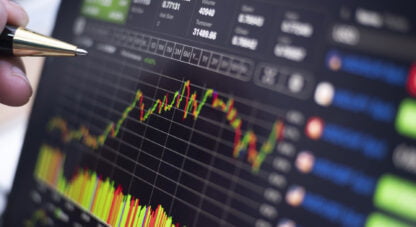Podcast: Play in new window
- Compounding silver ounces from 125 to 9500 ounces – Click Here to download the free report
- Invest with the next generation in mind
- Heart breaker, price maker, inventory taker, is the Fed’s theme song
The McAlvany Weekly Commentary
with David McAlvany and Kevin Orrick
Gold Hits All Time High and the Price Doesn’t Matter
July 29, 2020
David: All the money in the world doesn’t bring you relational connection and meaning. All the money in the world can’t buy a utopian existence. It’s been tried before. It’s been mandated. It’s even been forced in a top-down manner. That was, in large part, the 20th century narrative. You’ve got competing visions of the future with varying degrees of freedom and control with this utopian overlay.
–David McAlvany
Kevin: You know, last night when we were talking, we were Facetiming again because that’s how we’re doing our Talisker, and you’re doing your cigars, and there was a lot of activity. I noticed that your wife left, you know, and she gave dinner instructions to you, and I thought, oh, well, she’s at least taking care of you.
David: Yes, she had an obligation she was getting to. Said she’d be back around 9, 9:30. But our oldest boy, he’s got it dialed in. He knows what’s for dinner and he’s got it taken care of. So I go inside and I start talking to the kids and something is on my mind, and I’m like, now this is too important a teaching moment. This is kind of dorky of me, but I grabbed the chalkboard…
Kevin: (laughs) So this is what it’s like to be the son of Dave McAlvany.
David: I started. You know, we go through the perspective triangle. We go through how many loaves of bread an ounce of gold will buy. We talk about the gold/silver ratio. We talk about all these things. 45 minutes goes by and I’m like, alright, what’s for dinner? When is it ready? And Declan’s like it’s been ready the entire time. Oh, okay! (laughs) So we’re supposed to have potatoes with chili on top. We just ate the chili. We forgot about the potatoes altogether.
Kevin: You were just so absorbed. I mean, you were so absorbed in the whiteboard.
David: Well, Mary-Catharine was aghast. She came back and looks at this board is like, what happened here? It looks like you’re sort of planning the, you know, overthrow the world or something. It’s all there. The grand strategy. And the potatoes are still in the oven.
Kevin: Yeah, well, you know what? The kids are gonna remember that because Monday was a historic day for them. I mean, that’s when gold hit an all time high. So that’s when you get the whiteboard out. And you basically say, okay, prices don’t matter. Let me show you why prices don’t matter relative to dollars.
David: Yeah, it was an important conversation. My colleague Lila Murphy often says you’re never ready for what you expect. And no matter how hard you try to wrap your mind around a future circumstance, the circumstance and direct experience, those things are unique and you can’t be completely prepared for them. So this week silver briefly surpassed $26. Gold flew past the old highs set in 2011 to reach $1980 an ounce. That was in overnight trading and, you know we anticipated this price move but are still surprised by it somehow. We anticipate the demand dynamics for gold and silver continuing to be very strong in the months and years ahead, in response to the continued market dynamics like we have today.
Kevin: Well, this is predictable. I mean, massive deficits, you know, the economics that we’re seeing now, really, you talk about MMT (Modern Monetary Theory), we’re right in the middle of Modern Monetary Theory. Just print without stopping.
David: Yeah, if it’s massive deficits, if its massive money creation…it’s a new mode of economics, that’s what’s being initiated. And really, it’s an old type of Keynesianism. It’s new in the sense of the scale and the scope of demand management is shocking even to the Keynesian. So I think you’ve got savvy investors who have looked and said the playbook is more expansive this time. They’re playing out of the appendix, too, and so you have savvy investors opting out, opting out of the system since about 2008, 2009.
Kevin: And there’s a recognition that’s coming into the market again. This recognition is this is way, way too big to just be normal.
David: Yeah, the most recent move in metals prices is the beginning of the broader financial market’s recognition that all our central bank support is for an unsound house of cards. So what do we do? We build, we add onto an existing framework. We’re adding one layer after another onto the cards below, and because nothing bad has happened yet, we add to that edifice with greater boldness, and in the end I think we’ll find it to be misguided confidence. So stock markets globally, bond markets, too, they are, the internals of those markets are incredibly frail. So you take that speculative dynamic and then layer in central planning desperation, both on the fiscal side and monetary policy side.
Kevin: This is why you have to have Doug Noland on the show, because Doug Noland’s been writing about this for decades now. We’re just seeing the recognition in the markets.
David: He is. He’s joining us next week on the commentary to dive into the nitty-gritty. We need time to cover the eurozone stimulus that they announced in recent days, and it’s funded by common borrowing. This is a new iteration in the eurozone crisis and it’s really an identity crisis. Who are they? What do they want to be when they grow up? How are they going to function? It was a monetary union, now we’re talking about an implicit fiscal union. It’s very interesting.
Kevin: Well talk about identity crisis, what about China? Okay, it was communist and mechanically sort of a free market to some degree. But at this point, the tensions are rising and the credit is rising at a quicker pace.
David: Tensions are rising, and we do need to explore both China’s credit issues as well as the geopolitical tensions that are quickly boiling up and over. And, you know, it’s not as if we’re de-escalating. We’re doing our part to escalate those things, too. We’ve got plenty of China hawks back in D.C. between Navarro and Pompeo and the like. So we do have a lot to talk about with Doug. But that’s for next week. I would say that those issues, whether it’s euros on stimulus or China and China’s credit issues, they are very connected to the moves in golden and silver. But we’ll get into those in detail next week.
Kevin: You might recall, David, in February you sent a few people from the company to a conference. It was in Las Vegas, and the younger ones went into a room full of people. Now this is when COVID was just first starting out. It really hadn’t become news. One of the older dogs, Rob, he turned around. He did a 180 and he said, I’m opting out.
David: Way too many people, way too much noise. But it was an opt out. And when I think about the metals, precious metals are telling a story of investors opting out.
Kevin: That’s what I’m thinking. You just get out of the system.
David: I mean, you can look at Bitcoin and say the same thing. How’s it above 10,000 again? Well, it’s a different version of opting out. Probably not as reliable is gold if you’re talking about hedging. So when you talk about the metals, yes, it’s an investor opt out. Yes, it’s hedging. Yes, it is sort of a CYA if you’re going to continue to play in this crazy, artificially priced environment, some are still of the view that gold is money. Others look at it, and I think both of these are appropriate, but others look at it as stupidity insurance. And trust me, this is a bipartisan political jab. There are a lot of stupid ideas on offer and…
Kevin: They all cost a lot of money. Have you ever noticed that? They all involve printing.
David: But we don’t care anymore, as long as the advice is coming from a PhD or an M.D. If you have something authenticating your authority, then we take your advice and we won’t ask questions about consequences.
Kevin: So is the idea of liquidity changing? I mean, liquidity in the past has been cash, but they’re printing so much cash, is liquidity something more solid at this point?
David: Not necessarily. I mean, I think you still see people prizing treasuries and Bunds, and there are vehicles for liquidity. Cash is a liquid place to have one’s resources. But if you prize liquidity and you want to extricate yourself from financial market vulnerability, and wonder, maybe, as I do, if policymakers recognize how absurd their proposals of infinite printing and debt monetization are, then gold and silver make sense. Then it makes sense.
Kevin: Okay, so let’s just pretend for a moment, again, another thought experiment. Let’s pretend that the political absurdity suddenly ends and everything makes sense. The economic absurdity suddenly ends. Could we be at the ending of that and still have a problem that’s already been built in the past?
David: It’s difficult for me to go there. I mean, is this the end of policymaking absurdity? I don’t think so. Is this the end of stupidity where you don’t need that insurance anymore? I don’t think so. Is this the end of financial market volatility? Is this the beginning of currency stability? I mean, to me if you’re answering no to any of those questions, then this is not the end of the precious metals being priced to higher and even higher levels than we have today. Long term, I’d say 3 to 5 years, the prices will rise. Now my hope is—of course, the market never listens to me—but hopefully short term, the prices will correct, consolidate these gains. But often times the market is deaf to my requests or desires. I think at this point, if you’re looking at the metals market, you have to give the benefit of the doubt to the bullish metals thesis. Price action negates the alternative.
Kevin: You know, I talked to two types of people. We talked about this a little bit last week, but the people that are now seeing gold and silver hitting highs, a lot of them, they were just sick of it. They were so just done holding metals this last seven or eight years because they really wanted the pay off earlier. Now there were reasons why the payoff didn’t come in, but to sell their metals right now because they’re now breaking even, just saying goodbye, that’s sort of a sad way to move into this next phase, isn’t it?
David: Well, remember that psychology is all about the assets you’re purchasing, when you’re purchasing, the prices that you’re willing to pay. Right? So if you’re saying someone’s unhappy 5 to 7 years out, you know, where were we five years ago? Five years ago it’s 2015, gold’s 1050. Over the last five years, anyone who owns gold or silver is happy. Why? Because the prices are up. You’re really talking about someone who, seven years ago, was paying very high prices. Silver at $40, $50.
Kevin: 2011, 2012, yeah.
David: Gold at new all time highs. And here we are at new all time highs in gold. So this is the question. Is there reason to be cautious? Are we now chasing the trend? And I would say actually, to your point, we have a lot of people who would say “I just want out.” Surprisingly, it’s not “I just want in, give it to me at any price.” That was the dynamic in 2011.
Kevin: Most of those people that we talked to though that are selling based on price never had discipline in the first place. Price does not matter. It’s a longer-term discipline.
David: Well, I had a neighbor who bought silver at $20 several years ago and, as time passed, grew weary of holding the asset, seemingly dead, junk. In fact, it was junk. It was junk silver, the pre-1965 dimes, quarters, 50-cent pieces. So when the price recently surpassed $20 an ounce in March, the silver to be liquidated with an air of good riddance, almost an air of grievance. So finally, at break even, the desire to discard the asset was overwhelming.
Pay no attention to the reasons for Silver’s movement. Pay no attention to the environment of political or geopolitical uncertainty or to the freewheeling central bank interventions in motion, which are on an unprecedented scale that are, in our opinions, tempting fate with dysfunction and consequence. Somehow expectations, if I’m going back to this neighbor, expectations of immediate gratification, buy at $20, hopefully goes to $40, they were unmet for a number of years. And that set the tone for this person’s disgust with silver and desire to move on. So he sold it at $20, at break even, he walked away. And what do we do? We see silver at $20 and in this landscape, you know, attempting to dissuade the client…that person was rude. I mean, like, silver was odious and the purveyors of said asset were, too. To me, in some respects, it was a reminder that expectations determine a lot in life.
Kevin: We’ve talked so much about the dollar really not being what you want to measure anything in because the dollar may not even be around in five years. I mean, who knows what the value of the dollar will be. But what we try to do and Dave, your family has really taught many, many people this, including myself, measure an asset relative to another asset, something that you want to compound, something that you want more of. So when silver, like your neighbor, when he was selling that silver, he was selling silver, probably at the 90 to 1 level or somewhere in that range relative to gold, when, in reality, if he can just wait, there’s a repeating cycle where that silver would, you know if 90 ounces of silver buys an ounce of gold, there may be a day coming up soon, where 90 ounces buys two ounces of gold.
David: I mentioned the chalkboard. I had a conversation with my kids in front of a chalkboard, and so that was my night last night. Gold is reaching all time highs, and I wanted to remind them of what we’ve done for 50 years as a family.
Kevin: While the potatoes sat in the oven, uneaten.
David: (laughs) You’ve got to have your priorities. And by the way, I didn’t get the information. I thought it was just chili on the stovetop. I didn’t realize there was something that it was going on top of.
So it was a fun exercise, at least for me it was fun. You know, we’re teasing out the math of compounded wealth, and so what I did is I asked my oldest son, I wanted to use his stash as an example. 125 ounces of silver. That was the illustration. He saved and invested as he could through the years. So I framed the compounding of ounces and answered the question of when to sell. Actually, in this case, it’s when to transition from one asset to another, and it’s in the ratios. It’s not in the price. So thinking of the ratio, again, looking at the price of gold and the price of silver, dividing silver into the price of gold from over 100 to 1 to under 80 has been where, most recently in last couple of months, we will settle into the range of 40 to 60. That is the ratio in this cycle, and the trades that we’ll recommend, what I’ll encourage my own kids to do, they’ll be pushed through, and we just want to make sure that we’re set up for it. So 80 to1 at this point is still a great number. The 100 year and 200 year average is 31.4, so at 80 to 1, we have a long way to go to get down to that average. People will quote the 15 to 1 as a ratio or as an in ground number.
Kevin: That was artificial, too, because we were on a bimetal standard back when they were holding that at 16 to 1, right?
David: And when we saw it in the market, it wasn’t artificial. When the Hunt brothers were pushing things along, that was real buying. But it wasn’t sustainable. So it wasn’t artificial, but it also wasn’t sustainable because it’s not like there was a line of other people with checkbooks the size of the Hunts’ to keep on buying.
Kevin: So teach your kids and teach everyone to be realistic in their expectations. The old saying about it’s better to be 20% too early. Be reasonable in what you’re saying is, don’t look for 16 to 1 but yeah, you can look for 40.
David: Well, really, what I wanted to tell them is that long-term thinking is key. And I think, you know, as we played out the usefulness of long-term thinking in the utility of trading the gold/silver ratio, something that you know, there’s a lot of people who can talk about it, but not many people have ever done it. And that is one of the benefits of specializing in precious metals for the last five decades. So, you know, again trade in gold/silver ratio and going round trip from silver to gold back to silver again or vice versa. Gold to silver to gold, however you are counting it. That happens about once a decade. In average for the round trip, it’s about once a decade. That’s an average estimate, I would say. So I showed him how, all the kids were there, he had the opportunity at his tender age to take 125 ounces and grow it. And we grabbed a calculator and did the math. And of course, what I assumed was a tax-free account just because I didn’t want to factor in taxes into the illustration of compounding ounces, that just complicates the matter. So how do you take 125 ounces and in your lifetime grow it to 9,500 ounces? These were our assumptions, a trade a decade between 65 to 1 on the ratio and 35 to 1 on the ratio.
Kevin: So you were very, very conservative on the ratio.
David: Yeah, I’m not picking extremes, a Roth IRA to capture the compounding tax free, and you know he’s 14 years old. Seven round trips will be basically what he can do in his life, if that happens once every 10 years. This is a lifetime’s effort, implementing what is really just traditional compounding, but specifically applied to precious metals. And so, as I was explaining to him, one of our neighbors exiting the market, I’m saying this is just the beginning for you. This is not the end. I wish I could have persuaded my neighbor to take a different perspective, but gosh, one week cost him 30% as silver moved from 20 to 26 like lightning. So silver reaches what price for any of my kids to quit the strategy?
Kevin: The price doesn’t matter. The price in dollars doesn’t matter.
David: The price is irrelevant. What is a price when policymakers can peg 10-year Greek debt to a 1% rate of interest? What is a price when junk bonds are bought off the market by central banks, distorting the demand and supply dynamics? What is a price when central bankers, you could almost call it bonkers…
Kevin: (laughs) Central bonkers.
David:…are printing millions to control and influence the markets, and assume that there’s not gonna be any distortions or consequences or if there are they will be minimal. Price is not what we are playing for.
Kevin: So don’t try to compound dollars because the central bankers will always beat you at that game. You try to compound stocks or ounces or acreage.
David: Well and the reason why we do that was best illustrated by starting the conversation of the kids saying an ounce of gold is always equal to about 300-365 loaves of bread. Now through time, you could say a year’s worth of bread, that is one loaf per day, 365. Today it is about $5.50 a loaf, but back in the day cost just a few cents. So what has happened to our currency that it used to be a few cents for a loaf of bread, and now it’s $5.50? And I said, look, you’re not getting wealthy with gold and silver, you’re not. You’re just maintaining your buying power. So gold at $10,000 an ounce is the same thing as a $25 loaf of bread.
Kevin: So this is where compounding comes in. Your gold doesn’t earn interest. It does preserve buying power.
David: But I can expand my financial footprint regardless. If it’s acres, we want to compound them. If it’s square feet, we want to compound them the same, if it is shares in a publicly traded company, we want to compound them. We’re mindful of the opportunity to grow wealth over long periods of time. And precious metals fit this same model, using ratios to other metals and, frankly, to other asset classes. Right? So our conversation, our conversation on the chalkboard at home, was about compounding ounces.
Kevin: Dave, here at McAlvany you’ve created a really nice looking piece that explains all of this visually, so I would just encourage our listeners to click the link that’s attached to the show.
David: Yeah, if you want to request that piece, click through and do so. After 48 years of doing this, both between wealth management, asset management, and precious metals brokerage, and I realize 48 years in the grand scheme of things is not much, but our family, at least when it comes to compounding ounces, I think we can put you on the right path. And frankly, not all clients want that. Not all clients have the patience for it. But what I was describing to all of my kids last night was a seven-decade project, right? And I appreciate that most of my kids haven’t even passed their first decade, let alone can imagine the next seven.
Kevin: Do you know what you’re doing when you do this, though, Dave? So often I hear from people, “Well, I just want to spend my retirement. I don’t want to hand it down to my kids.” That’s not a legacy mindset. This life really is not all about us. This is about moving legacy through the generations, you’ve talked about that a lot, but you know, a person has to have a rescuer mentality, not just a profit-for-myself mentality.
David: And some of this for me is math, over time the value of money. You do the math of compounding over 70 years and realize that the majority of the benefit comes at the end of the cycle. It’s on the sixth and seventh round of doubling. And in this case, it’s ounces. What they realized at the end of the conversation is this is one vast game, and the way it’s played is too often short circuited when, as you described it, Kevin, we make it about us. So my daughter, nine years old, asked, “But what if my kids learn to do this and you get to add another 50 years to the process?” That’s what I want.
Kevin: The math blew her mind, I’m sure.
David: It continues to because it’s a form of pro forma numbers that, you know, I’m telling you, if you want buy-in for how you want your kids to dream and think of the future and begin to take ownership of making responsible decisions relating to their finances today, even if it’s a dollar here, a dollar there, right?
Kevin: Dave, I remember when you and your mom and dad and the family went to Germany, and we were talking while you were in Germany and you were telling me about this family, talk about legacy, this was a family, this castle I think you went to, right? And they had lasted how many generations? I mean, through thick and thin, through all types of politics.
David: Burg Eltz, burg is the word for Castle, so the Eltz Castle. That’s where conversation with my daughter went when she asked about 50 years after she’s done with her contribution, launched us back into the conversation about the Eltz family in Germany. 32 generations. 950 years. And I mean it’s a unique story, not often repeated. I get it. That’s just the way it is, but I would argue that one reason it is such a rarity is that from generation to generation we quit playing the game, and we make it all about us. The idea of stewarding wealth through the generations is foreign. We’re only in tune with our immediate wants and needs.
So last night I told the kids for the first time, I’d never told him this before, but last night I told them for the first time that I had silver that I bought for each of them. I didn’t tell them how much. I never told them that before, but I wanted them to have this idea impressed on them, the importance of thinking not in terms of your needs but the needs of the next generation. The game started for them—this was a revelation to them—the game started for them at age one, not at age 21 or 31 or at 41, when most people start thinking about the future, retirement, what have you. And I tell you, the impact of capturing that extra 20 years of compounding, from 1 to 21, this is really remarkable. If we took those extra two turns, you know, for my son using his ounces, 125 ounces, that stash that he has today, add two more decades to the equation, which, in effect, I have done for him. Two more opportunities to double ounces, and his theoretical 9,500 ounces ends up being 32,848.
Kevin: So he starts at 125, gets to 9,500, you go a couple of more rounds…
David: 32,848 is the potential over a 90 year stretch from 125. And I’m telling you, anybody flipping burgers at McDonalds can save and have 125 ounces of silver. This is not pie in the sky, and it’s not out of reach of anybody. But that is 90 years to get a 262-fold return. That’s a long time. But in retrospect, because of the nature of the doubling function, that is a 291% rate of return annually.
Kevin: And you’re teaching your kids to think about the next generation and the next after that, even.
David: So my neighbor was happy to exit a $20 an ounce because there’s no such engagement with the future, just an immediate expectation unmet, disappointed. Getting to break even was a victory. I’ll play the game for the next generation and assume the victory is in teaching them how to play the game for the generation that follows them. Can they become teachers of teachers? Implicit is that it’s not about you.
Kevin: I’ll have to tell you a story. I don’t think I’ve ever told you this, Dave, but my mom, as I was growing up … I didn’t know my great grandparent’s very well. They came over from Russia, but they were prayer warriors and they would pray for generations going forward, and my mom would tell me as I was growing up, that I was prayed for long before I was born, she was prayed for before she was born. And, you know, when you teach people the longer goal, I’ll never forget that. You know, I never really knew my great grandparents from Russia, but I know I was prayed for.
David: You know, if you can to some degree see the future, you can more easily live into the future. As I think about the conundrum that we face in the inner cities today, a lot of it is that there is really no imagination for something on the horizon. It’s a tough life, there’s not a lot of opportunity. Education stinks. Leadership, community dynamics, family dynamics, there’s really nothing that casts a vision that you get to live into. There’s so much overcoming just to survive, let alone thrive. That is an opportunity that we have in the context of family, to see the future to live into the future. So the whole conversation launched us back into talking about our identity within a family. Our identity as a family within a community, the part that we play within the community in this country, the United States, and in the broader world. But the way I laid it out was the concentric circles of involvement. Actually, I’m borrowing it from John Paul II’s principle of subsidiarity. I didn’t tell them that, they wouldn’t have remembered that word anyways. But these concentric circles of involvement and the role we’re to play in each of these spheres…
Kevin: So it’s not just about compounding ounces, compounding wealth. It’s about compounding these spheres.
David: Well, I mean, if we’re thinking about ounces and acres and square feet, there’s a game to be well played. But you play the game the best you can in the midst of a life that is to be well lived. Bear in mind the opportunities, the opportunities to bring a refreshing presence into the world, to bring change and hope, and yes, resources to bear on making each of those spheres better. So one of our family traditions in Christmas time is we always watch It’s a Wonderful Life. So last night I brought it up again. We talked about George Bailey. We talked about Mr. Potter from the story It’s a Wonderful Life, and this is the deal. I want them to have an idea of what all the money in the world looks like. But I also want them to have an idea that all the money in the world doesn’t bring you the things that matter most. So you play the game well so that you can live a life well, that is, skillfully. But all the money in the world doesn’t bring you relational connection and meaning, all the money in the world can’t buy a utopian existence. It’s been tried before. It’s been mandated. It’s even been forced in a top-down manner. That was, in large part, the 20th century narrative. You’ve got competing visions of the future with varying degrees of freedom and control with this utopian overlay.
Kevin: We were talking last night because you allowed me to pre-read a chapter of a book that you’ve been asked to write on family, and we talked about it. You’ve got the top-down approach, which is the centralized approach, like you said, with utopia. That always fails. In fact, not only fails miserably, but it fails with blood. But the family, it’s actually the bottom-up. It’s these concentric circles you’re talking about, and you bring this up in your chapter, this chapter that you’ve been asked to write for a book on family. You bring up just how powerful the effect of the bottom-up approach is.
David: Well, I mean, ironically, when we think about the opposite, we’ve got the top-down management structure that appears to be the current trend in the market place. Manage the business cycle with all the money in the world, and you might get some policymaker’s vision of utopia. I know you’ve heard it said that one man’s trash is another man’s treasure. Well, one man’s utopia is another man’s dystopia, and I think that’s what we’re playing with here is we now have access to all the money in the world, and we want to control the business cycle. We want to control outcomes according to one man’s idea of utopia. And who is that one man? I mean, look, you can pick out of the 535 folks back in Washington, just pick one, because one of their visions of utopia, that’s what’s in motion.
Kevin: How in the world do you wean yourself, then? If you’re a large centralized organization, how do you wean yourself from that?
David: You know, I think one of the best articles I read this last week was from the Economist, July 23rd Edition. An article titled “Governments Must Beware the Lure of Free Money,” and it describes this once in a generation shift in economic thinking, which, it’s underway. It’s now happening. The article describes it this way. And I quote, “Each new era of economics confronts a new challenge. After the 1930s, the task was to prevent depressions. In the 1970s and early ’80s, the Holy Grail was to end stagflation. Today, the task for policymakers is to create a framework that allows the business cycle to be managed and financial crises to be fought without a politicized takeover of the economy.” That’s the end of quote.
As I thought about that, number one it’s an important article. The key point echoes Carmen Reinhart’s: Someone is choosing winners and losers. That is public policy, choosing winners and losers. That idea of politicized takeover of the economy, that describes this shift in November with competing views of who wins and who loses. And so I’m not saying that, oh, if Trump wins, he’s going to choose winners and losers. If Biden wins, he’s not. No, this is the way it is going forward. Whoever wins is choosing the winners and losers according to a vision of what this country should be. That describes the shift in November. The challenge, as the article describes it, is to avoid the infinite opportunities for politicians to play favorites. So that’s where the article goes, it concludes with I thought a very straightforward warning: “The stakes are high. Failure will mean the age of free money eventually comes at a staggering price.”
Kevin: And so the rise in the gold market at this point is, basically, there is a group of people out there who are saying the stakes are high and this is probably going to fail.
David: Yeah, this is a really contemplation by a growing audience of investors that the price of this experiment will be staggering. Add to the metals prices a complement from what you see in other markets, stubbornly low yields in treasuries in German Bunds and what it suggests is a massive divergence in financial market opinion compared to the stock markets and their push higher off of the March lows. You’ve got the NASDAQ marking … its now above 25% gain for the year. The S&P 500 has pushed higher, and, of course, it’s been pushed higher mainly by 5 to 7 names, to a gain for the year. The Dow Jones industrial average is just a short distance from breakeven. So it’s actually underwater for the year, you know, after its first quarter meltdown.
Kevin: So you have two bets out there. You have the safe haven bet, which, golden and silver’s going up, and then you have the other people who say, look, the experiment’s going to work. They’re printing money and it’s working. Let’s just go buy stock.
David: The safe havens are telling you two things. There’s a real concern for liquidity, as evidenced by low yields in German Bunds and treasuries. And so government debt, as mispriced as it is, still garners a massive audience. And I mean, look, we talk about this all the time, but the audience for government debt, it is abnormal. Those participants, you know, the central banks in the mix, too, and they’re only too happy to keep yields low enough because what does it do? It accommodates their ecosystem, it accommodates the massive increases in debt. Low rates increase total quantity of debt, so that’s point number one. The second is, as much as there is a concern to be in liquid, perceived safe fixed-income instruments, back to Bunds and treasuries. You also have a push into the metals markets. Gold and silver are suggesting something. It’s interesting, copper, too, that inflation can’t be ruled out. Silver and copper are much more inflationary sensitive.
Kevin: They have a sensitive nose. You know, I’ve always looked at silver and, like you said, copper. But silver just seems to smell inflation early.
David: The interesting thing about copper, usually called Doctor Copper, is a predictor of economic activity. Only you can dispel that in this context and say, actually, the messaging is different. It’s not about demand, because the global economy is getting ready to start cranking out impressive growth numbers, and we’re back to normal. Without COVID being behind us, I don’t think that claim can be made. At the same time, silver is moving higher. I think it suggests that silver and copper are speaking about an impending inflation.
Kevin: Well, I wonder then, okay, because we have social disruption to a degree that we haven’t seen in a long time. But if you go back and look at history, inflation is the true igniter of a fire, a social disruption fire. We ain’t seen nothing yet if we have inflation.
David: No but we could go right back to Tunisia, we could go right back to the Arab spring. If we end up with rising inflation, you may want to recall the Arab spring and transport that dynamic globally. Only it would be the, you know, once upon a time middle class spring. You know, you’re talking about the evisceration of middle class, with higher rates of inflation already in a tenuous situation because of a global pandemic. And what could you have? A global version of the French Revolution? I mean, that’s being teed up if the inflation genie gets out of the bottle. Deflation, who does it hurt? Deflation hurts the asset-rich. Deflation hurts the creditor class, so the battle lines have been drawn there for several decades, with the central banks protecting friends and family. But the shredding of social fabric, this is different. The shredding of social fabric comes through devaluation of a currency. Metals are indicating a nervous sense that the masters of the universe may not be able to take care of their own forever, right? So you get central banks protecting the financial sphere from collapse, and that may very well come at the price of a shredded social contract.
Kevin: Do you remember, again, we bring him up so often, but Richard Bookstaber, he was part of the Dodd-Frank legislation that came in? You know, the old saying is that always the regulations that come in are for the last crisis, not the next crisis. And one of the things that he brought up that really worried us was, the Dodd-Frank bill really discouraged market makers, individual, private, or corporate market makers. The central banks have become the market maker of everything. In other words, they’re just the buyer of stocks, they’re the buyer of bonds. So at this point, do we really have a real market? And what happens when everybody wants to sell?
David: Yeah. So you’re trying to solve the problems of unfair dealings and of protection of the consumer, you know, in a post-real-estate crazy environment, that post 2007, 2008, 2009, Dodd Frank was launched, and its legislation … this is what Bookstaber was contributing to. And he was solving that problem. He knew that the structures put in place would create new problems. So that’s what’s happened. Central banks have been forced into the role of market maker, and it’s for a growing list of assets. It’s not just asset-backed securities, mortgage backed securities. I mean in some countries, it’s only government debt, but in other countries it includes corporate debt, municipal debt, even stocks, even equities. So Dodd Frank made market making less attractive for the old guard and now the central banks are in the position of having to be price maker and inventory taker for all things financial.
Kevin: Okay, so they’re the price maker and inventory taker. I heard you say that before and it brought to mind…okay, sorry, 1979, okay, I was 16 years old in 1979. Pat Benatar sang a song.
David: (singing)
Kevin: Yeah okay, but I’m going to change the word. Heartbreaker, price maker, inventory taker, don’t you mess around with me. See they’re everything at this point. They’re everything. And the truth of the matter is, they are the price maker. We don’t have free markets. They’re the inventory taker.
David: That’s the road to a $10 trillion balance sheet and then 20. We’re on the road this year to annual deficits of 20 to 30% of GDP. A single year, 20 to 30% to GDP deficit. I mean, this is mind-boggling.
Kevin: Enter monetary theory. But we call it modern now, Modern Monetary Theory.
David: Right. Modern Monetary Theory is one giant manured muck up. It’s nasty. Your average equity investor is going to get it last. They love the fact that money’s on offer and there’s a floor in the market. That’s what they believe. Where do you see indications that it’s actually not healthy and not going to end up well? First, it’s the currency or fixed income investor who gets twitchy and moves. In this case, you can’t tell much from the fixed income investor because of the government-financed pricing structure that’s in place today. But the RMB is saying that trouble is coming. The USD, the US dollar says trouble is here, and gold and silver, despite near term corrections, I’m open to. Despite those near term corrections, it’s telling you that this system is jacked up, and if you haven’t opted out, you may want to think about it real soon.

















